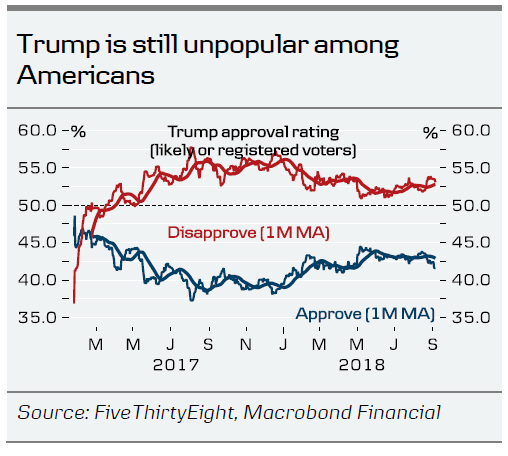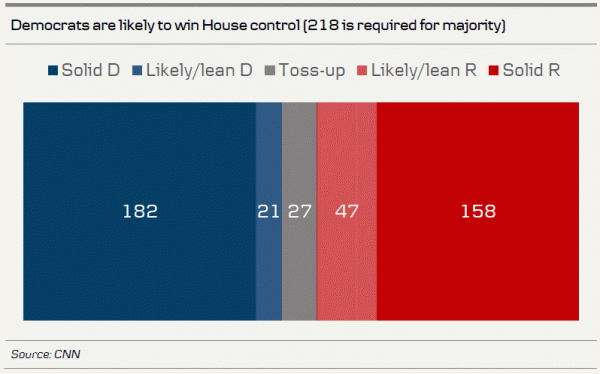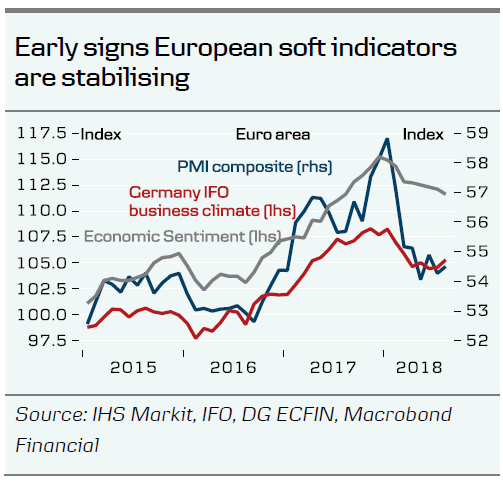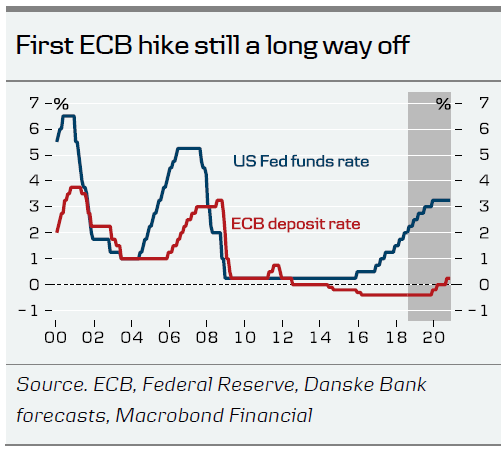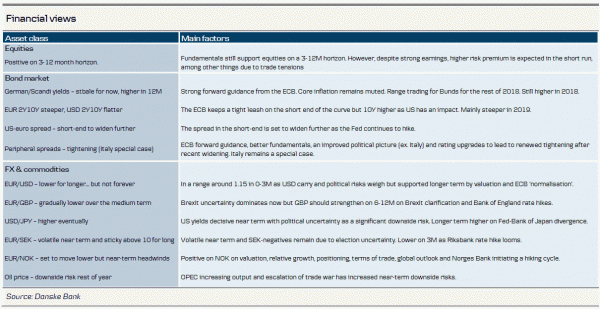Today’s key points
- US midterm election is mostly a political event not an economic event.
- We expect the market implications to be limited, as Trumponomics is unlikely to be rolled back.
- In Europe, there are early signs that soft indicators are stabilising, meaning that growth will probably remain at current levels.
- We still do not expect the ECB to hike before December 2019, as inflation remains subdued.
US midterm election is mostly a political event
Trump’s first real political test is on Tuesday 6 November, when the midterm elections take place. While media coverage is going to be intense, we think the election is mostly a political event not an economic event, which we discussed in depth in US Midterm Elections – Mostly a political event with limited implications for markets and the economy, 4 September. We believe the US expansion is set to continue in coming years, as optimism remains high and fiscal policy remains expansionary.
The most likely outcome is that the Democrats win the House but the Republicans retain Senate control. This would make President Donald Trump a ‘lame duck’ in the sense that he cannot get through with his domestic agenda. Trump’s focus would remain on foreign and trade policy. If the Democrats win the House, we believe they are likely to start an impeachment process against Trump. While this would create a lot of headlines and noise, we do not think Trump would be convicted, as this requires a super-majority in the Senate (impeachment is a political, not a legal, verdict).
Even if the Democrats win control of both chambers, it would be difficult for them to roll back Trump’s laws/policies, as Trump can veto any attempt to do that, which should limit the immediate impact on US Treasuries. The higher government deficits ahead would increase US Treasury issuance and put upward pressure on long-end US yields. The midterm elections are also unlikely to change the Fed’s outlook despite Trump’s criticism. The flattening of the US yield curve remains the main focus.
EUR/USD and real rates have moved apart under Trump. In a scenario where Trump ends up a ‘lame duck’ after the midterms, it could support the USD somewhat (and weigh on EUR/USD), as the ‘Trump discount’ may start to be priced out. History suggests that the midterm elections are secondary for equities. We are positive on equities, as returns are more dependent on macro than politics, although volatility may be higher.
European indicators are stabilising
Growth in the euro area has slowed this year, from 0.7% per quarter on average in 2017 to 0.4% in both Q1 and Q2 18. Euro area soft indicators have fallen sharply this year but part of the story is that growth was never as strong as the indicators showed. Now there are early signs that the soft indicators are stabilising, suggesting that growth will stay around the current level. This is also visible in the euro area surprise index, which is back to neutral after its sharp fall earlier this year. This is good news, as it suggests the European expansion is continuing, although at a slower pace than in 2017, and we expect the unemployment rate to decline further. As the expansion is not as old as the US expansion, the expansion has further to go still.
Despite above-trend GDP growth, the European Central Bank is a long way from raising rates, as the inflation pressure remains subdued. We expect the first hike to come by the end of 2019 and next week’s ECB meeting is likely to be undramatic. We still expect the ECB to end its bond-buying programme by the end of this year. For more, see ECB Preview – For the feinschmeckeres, 7 September.
Following marked growth divergence in favour of the US, we believe the relative cyclical picture is starting to shift with the improved economic data in the euro area. Short term, we think the relative-rate support for USD and EUR political risks will dominate, leaving EUR/USD in the sub-1.15 range but we see the cross staying above 1.10. At yearend, when the relative cyclical picture may shift in favour of the euro area and the euro capital outflows of recent years are fading when the first ECB hike draws closer, we think EUR/USD will move higher again. We forecast EUR/USD in 1.18 in 6M and 1.25 in 12M.
We still expect a steeper EUR yield curve on a 12-month horizon. The ECB still maintains a relatively tight grip on the short end of the curve. However, this is not the case for the 10Y segment of the curve, which we expect to be pushed higher by rising US yields, the end of ECB QE from the ECB and the pricing of rate hikes in 2019/20. For more see our Yield Outlook, 14 August.




